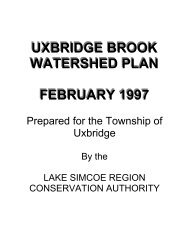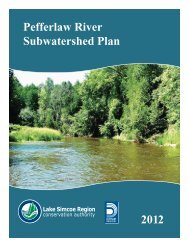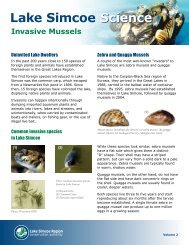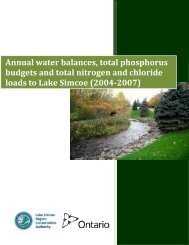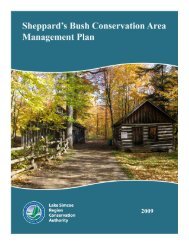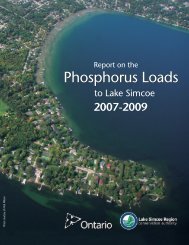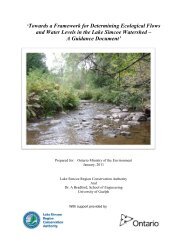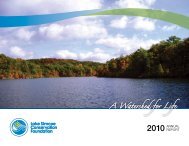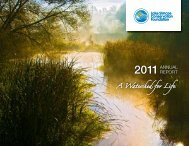Barrie Creeks, Lovers Creek, and Hewitt's Creek Subwatershed Plan
Barrie Creeks, Lovers Creek, and Hewitt's Creek Subwatershed Plan
Barrie Creeks, Lovers Creek, and Hewitt's Creek Subwatershed Plan
Create successful ePaper yourself
Turn your PDF publications into a flip-book with our unique Google optimized e-Paper software.
The <strong>Barrie</strong> <strong><strong>Creek</strong>s</strong>, <strong>Lovers</strong> <strong>Creek</strong> <strong>and</strong> Hewitt’s <strong>Creek</strong> <strong>Subwatershed</strong> <strong>Plan</strong><br />
A general overview of the current fish communities is looked at first to see what type of fish are<br />
at a site (cold water species 1 , warm water species 2 , or no fish) <strong>and</strong> what the temperature of the<br />
creek is at the site (cold, cool or warm water), as well as the location of dams that block<br />
passage for some fish species (Figure 5-2). This broad overview can show the general shifts in<br />
the fish communities as coldwater fish communities either change into warm water fish<br />
communities or habitat absent of fish, as water temperatures rise or where dams are present.<br />
Figure 5-2 shows that temperature varies along most of the watercourses. Despite this, cold<br />
water species, such as brook trout <strong>and</strong> mottled sculpin, can be found across all three<br />
subwatersheds. There are also a number of sites that either have only warm water species or<br />
no fish species at all. The dams depicted on the map also show where the major barriers to fish<br />
are located.<br />
There are a few anomalies where cold water species are found within warm water habitat or<br />
warm water species in cold water habitat. The most likely reason that cold water species are<br />
found in warm water habitat is that there are small nearby temperature micro habitats, such as<br />
undercut banks <strong>and</strong> heavily shaded areas with cold water upwellings, springs or seeps. It is<br />
also possible that a species was passing through or leaving the warm water habitat at the time<br />
of sampling, but this would be more unusual. Warm water species are habitat generalists <strong>and</strong><br />
can exist in warm, cool or coldwater conditions.<br />
An Index of Biotic Integrity (IBI) was used to assess the ecological integrity of the creeks<br />
through the composition of fish communities within the system (Figure 5-3). Fish population <strong>and</strong><br />
community composition surveys are valuable tools in examining the health <strong>and</strong> stability of<br />
streams <strong>and</strong> rivers. Over time, shifts in composition along with the presence or absence of key<br />
species not only provides an indication of system health but can be used to help identify what<br />
ecosystem stressors, such as climate change <strong>and</strong> urbanization, are influencing aquatic habitats.<br />
With this method there are five rankings that can be assigned to a site:<br />
• Very good: Excellent diversity, top predators, trout present <strong>and</strong> high fish abundance<br />
• Good: Average diversity, top predators present, trout present, average abundance<br />
• Fair: Low/average diversity, some top predators, no trout, low/average abundance of<br />
fish<br />
• Poor: Low diversity, no top predators, no trout, low abundance of fish<br />
• No Fish: No fish were captured at these sites<br />
While the IBI is generally applicable to the Lake Simcoe watershed, there is potential for<br />
improvement by including a greater range of top predators into the IBI calculations. Currently<br />
only brook trout are weighed <strong>and</strong> measured individually. This may skew the results as warm<br />
water predators are not included in the IBI calculations.<br />
Overall, Figure 5-3 shows that the ecological integrity of the systems vary spatially across the<br />
subwatersheds, with many of the sites showing fair conditions. There are also several ‘good’<br />
ratings in each of the subwatersheds, as well as a number of sites that were rated as having<br />
poor ecological integrity. It is also important to note that all headwater sites within the <strong>Barrie</strong><br />
<strong><strong>Creek</strong>s</strong> subwatershed had no fish captured.<br />
1 Cold water species are indicators of cold water habitat. Coldwater species found in these subwatersheds include:<br />
rainbow trout*, brook trout, rainbow smelt *, mottled sculpin <strong>and</strong> slimy sculpin (*not native to Lake Simcoe<br />
watershed). All others listed in Table 5-2 are either cool or warm water species.<br />
2 Warm water species are considered to be generalist species that are not coldwater indicators <strong>and</strong> can exist in warm,<br />
cool <strong>and</strong> coldwater sections of a stream.<br />
Chapter 5: Aquatic Natural Heritage 211





